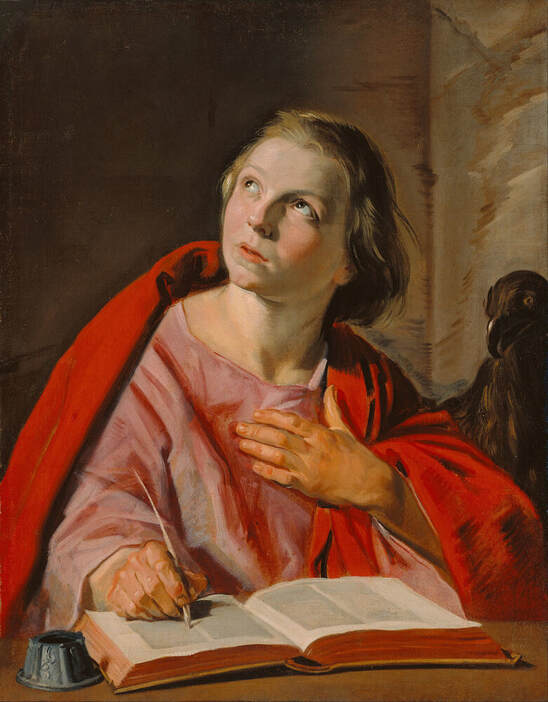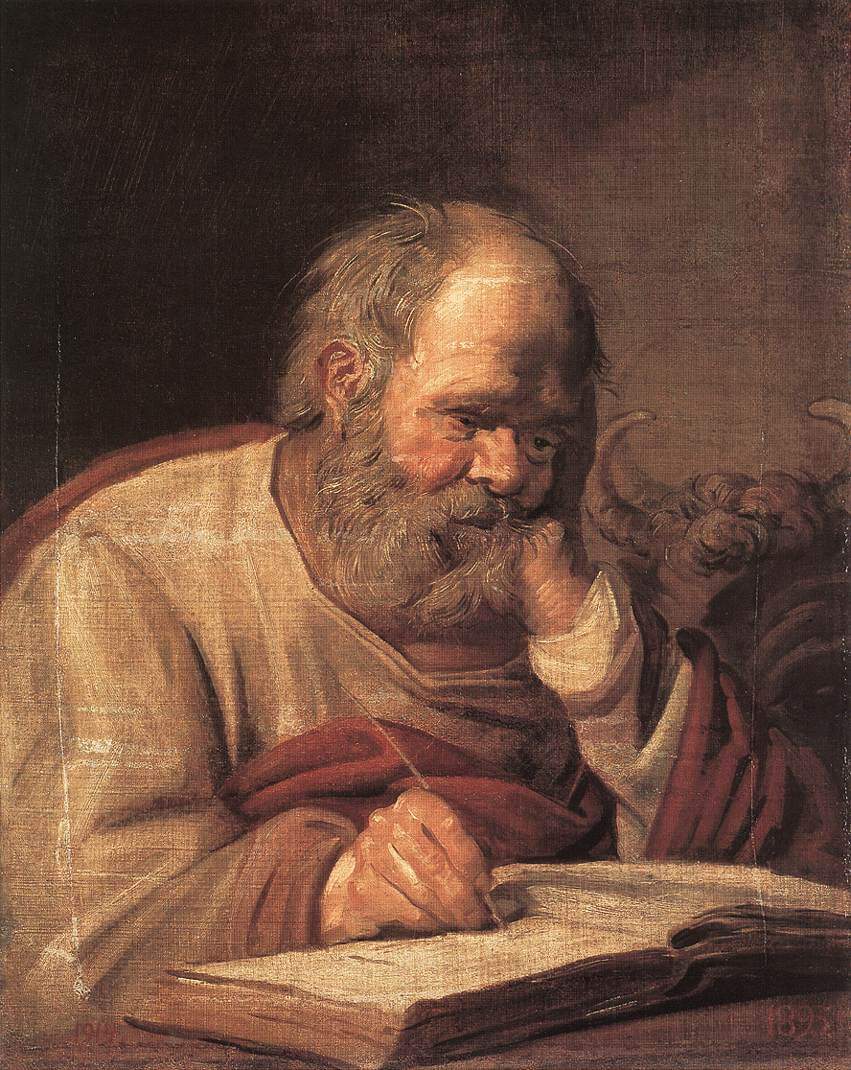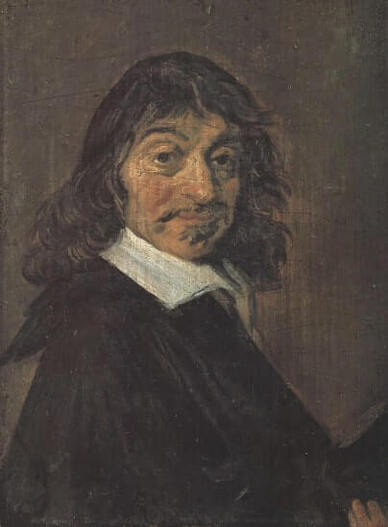|
Where? Room E203 of the J. Paul Getty Museum
When? 1625 What do you see? A young Saint John the Evangelist sits in a room. He has red cheeks and wears a red/pink robe with a bold red cloak over his shoulders. He looks up into the light which represents the divine inspiration for the writing of a Biblical book. Saint John holds a quill pen (a pen made of a bird feather) in his right hand, and he has just dipped the pen in the pot with ink on the bottom left. He presses his left hand pressed to his heart to indicate his personal faith that helped him to write the Biblical book. On the right is an eagle which is one of the attributes of Saint John the Evangelist. Frans Hals used broad visible brush strokes to create this painting. His brush strokes are more refined in the face of John. He also makes brilliant use of the light to depict John the Evangelist. Backstory: This work is one of the few religious paintings by Frans Hals. About eighty percent of his works are individual portraits of upper-class people, wedding portraits, or group portraits. The remainder of his work consists mostly of genre paintings. The painting of Saint John the Evangelist is part of a series of four paintings of the apostles, with the other ones being St. Matthew, St. Mark, and St. Luke.
Who is Saint John the Evangelist? The author of the Gospel of John, the fourth book in the New Testament. Before becoming an Apostle of Jesus he was a fisherman. However, it is not certain if the Apostle John is also the author of the Gospel of John, as the author does not clearly identify himself in his writings. He is the only apostle that was not killed because of his faith in Jesus. Some people also attribute the Book of Revelation to him, though this is also a point of debate among scholars.
Who is Hals? Frans Hals the Elder was born by the end of 1582 (or early 1583) in Antwerp, Belgium, and died in 1666 in Haarlem, The Netherlands. His brother and five of his sons were also painters. Frans Hals is primarily known for his portraits. He had a loose painting style, which means that he used relatively few (but long) brush strokes to depict something. You can often see the brush strokes in his paintings. He painted based on his intuition and was uniquely able to capture the emotions and characteristics of the people he painted. Together with Rembrandt and Johannes Vermeer, Frans Hals is generally considered the best Dutch painter of his time. While living around the same time, the three of them all had unique styles and never met each other in person. Another interesting painting of Hals is the Portrait of René Descartes, the father of modern Western philosophy. This painting is in the Statens Museum for Kunst in Copenhagen. There are several copies of this painting among which one is in the Louvre in Paris.
Fun fact: This work is part of a series of four paintings in which Frans Hals depicted each of the four evangelists: Matthew, Mark, Luke, and John. All four paintings were lost since 1812 and were only rediscovered during the 20th century.
Cornelis Hofstede de Groot mentioned the four paintings in a catalogue raisonné in 1910, but not much attention was given to these mentions as they seemed to be atypical in Hals’ oeuvre. This changed in 1958, when Irina Linnik, an art historian for Odessa Museum of Western and Eastern Art, rediscovered the paintings of St. Matthew and St. Luke. These two paintings can still be seen in the Odessa Museum of Western and Eastern Art in Odessa. In the 1970s, Claus Grimm identified the painting of St. Mark, which is now in the Pushkin Museum of Fine Arts in Moscow. The Getty Museum paid $2.9 million for St. John the Evangelist in 1997, when it was rediscovered by Brian Sewell when the painting was brought in for evaluation at the auction house Sotheby’s. Interested in a copy for yourself? Poster or canvas.
Written by Eelco Kappe
References:
0 Comments
Leave a Reply. |
Categories
All
|
- Home
- Blog
-
Museums
- Alte Pinakothek
- Art Institute of Chicago
- Baltimore Museum of Art
- Barber Institute of Fine Arts
- Bargello
- Barnes Foundation
- British Museum
- Church of Sant’Anastasia
- Cleveland Museum of Art
- Courtauld Institute of Art
- Detroit Institute of Arts
- Frans Hals Museum
- Galleria Borghese
- Gallerie dell'Accademia
- Getty Museum
- Guggenheim
- Hermitage Museum
- Kunsthistorisches Museum
- Kunstmuseum Basel
- Legion of Honor Museum
- Louvre
- Mauritshuis
- Metropolitan Museum of Art
- Musee d’Orsay
- Museum of Fine Arts in Boston
- Museum of Modern Art
- National Gallery in London
- National Gallery of Art
- National Museum in Poznań
- Norton Simon Museum
- Ny Carlsberg Glyptotek
- Palace of Versailles
- Palazzo Pitti
- Palazzo Vecchio
- Petit Palais
- Philadelphia Museum of Art
- Prado
- Pushkin Museum
- Ravenna Art Museum
- Rijksmuseum
- San Diego Museum of Art
- Santa Maria delle Grazie
- St. Peter's Basilica
- Städel Museum
- Statens Museum for Kunst
- Tate Britain
- Tate Modern
- Timken Museum of Art
- Uffizi
- Vatican Museums
- Wallace Collection
-
Artists
- Altdorfer
- Anguissola
- Berlin Painter
- Bosch
- Botticelli
- Boucher
- Bronzino
- Bruegel the Elder
- Brunelleschi
- Cabanel
- Caillebotte
- Canova
- Caravaggio
- Carpeaux
- Cezanne
- Cimabue
- David
- Degas
- Delacroix
- De Maria
- Donatello
- El Greco
- Fontana
- Fra Angelico
- Fragonard
- Gauguin
- Gentileschi
- Gericault
- Gonzalez-Torres
- Goya
- Hals
- Hogarth
- Hokusai
- Ingres
- Leonardo da Vinci
- Lippi, Filippo
- Longhi, Barbara
- Lorrain
- Makovsky
- Manet
- Massys
- Matisse
- Merian
- Michelangelo
- Mochi
- Modigliani
- Monet
- Panini
- Parmigianino
- Perugino
- Picasso
- Pisanello
- Raphael
- Rembrandt
- Renoir
- Reynolds
- Rivera
- Rodin
- Rubens
- Scultori
- Seurat
- Steen
- Tintoretto
- Titian
- Toulouse-Lautrec
- Turner
- Uccello
- Van der Weyden
- Van Dyck
- Van Eyck
- Van Gogh
- Van Hemessen
- Vasari
- Velazquez
- Vermeer
- Veronese
- Vigée Le Brun
-
Locations
- Books
- About Us





